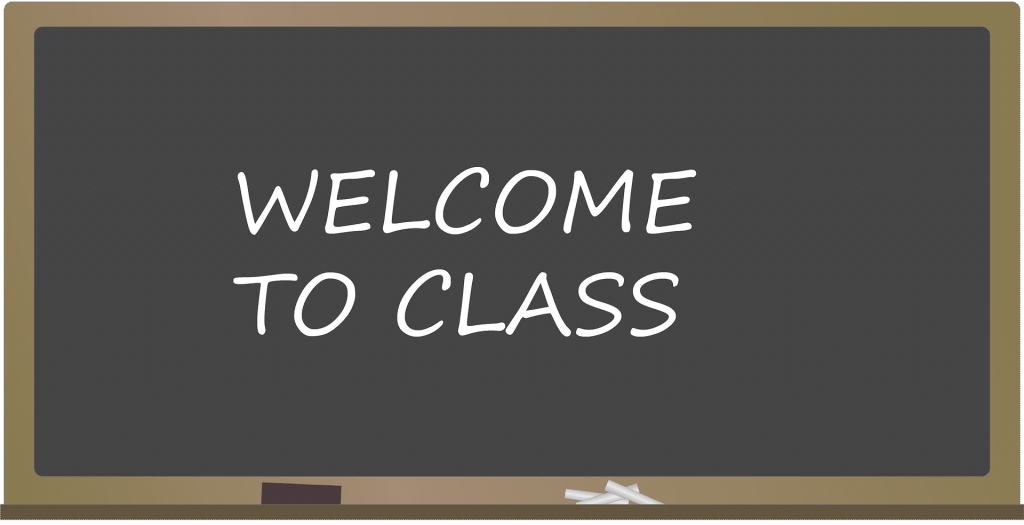-
Interactive Compositional Classrooms

Active Learning One of the courses I am taking this semester focuses on compositional pedagogy in high school and college settings. As I prepare to enter an English 1101 classroom next fall as part of my graduate-level training, I am beginning to strengthen and hone in on my philosophical approach. Each week consists of required readings and analysis of those readings to include “takeaways.” As a student, sometimes it seems like an over-abundance of information while searching for the needle in a haystack, so to speak, or rather, the fundamental components of classroom pedagogy that resonate in some way with one’s perceived educational platform. However, that moment when you read something that seems to vibrate on a frequency so profound that you want to shout with excitement, is, well, EXCITING!

Discovering Your Frequency Chris M. Anson’s discussion found in chapter one of First-Year Composition: From Theory to Practice is one such piece for me. Anson discusses a pedagogical approach known as WAW (Writing About Writing – see video below), which defines and addresses writing as a process. Following the WAW approach, the focus is less about the ability to write and more “ . . . on thinking about the thinking that writing involves . . .” Anson further states, “Developing ‘mindfulness’ and meta-cognitive awareness becomes one of the most important aims . . .” (5).
Wardle and Downs (WAW) Any many of you know, last semester involved studying Adler-Kassner and Wardle’s threshold concepts from Naming What We Know, specifically, threshold concept five: Writing is (Also Always) a Cognitive Activity. As I read through Anson’s excerpt, I found myself shaking my head, yes! over and over. Anson structures his classroom to feature “extensive, low-stakes and reflective writings” (6). This process of giving students many opportunities to participate in “low-stakes” writing is something I most definitely want to incorporate in the classroom. I feel as though “de-stigmatizing” the process of writing is essential for students to become comfortable with approaching writing as a process —not something that is easy for those that enjoy writing but a process that writers of all levels can use to develop the skill.
I believe just about every college student has experienced the “PowerPoint lecture” classroom design that seems to go on for eternity. No matter how awake you may feel or how artistically designed the presentation may be, the lights dim, and the eyes get heavy. The advancement of classroom technology and the emergence of digital course discussion boards demand a change in how the class time is structured. When I read Anson’s “course delivery reversal” (CDR) (10) design, I wanted to jump up and down. Instead of professors spending the entire class period lecturing in front of the students, Anson takes an interactive approach. Presentations can be posted to the online digital boards, and students then have the opportunity to engage, discuss, and learn through interactive projects. My goal is to incorporate this same type of pedagogy in my English composition classroom. Since writing is known to be a social and rhetorical activity, the more time students spend conversing, the more enhanced the process of writing will become. Below is a video where Anson discusses the importance of this concept in regards to interaction between teachers and students in the field of writing.
Chris Anson – 2013 CCCC Convention Interview Works Cited
Adler-Kassner, Linda, and Elizabeth Wardle, editors. Naming What We Know: Threshold Concepts of Writing Studies, Classroom Edition. Utah State University Press, 2016.
Anson, Chris M. “Writing, Language, and Literacy.” First-Year Composition: From Theory to Practice, edited by Coxwell-Teague, Deborah and Ronald F. Lunsford, Parlor Press, 2014, pp. 3-19.
“Chris Anson – 2013 CCCC Convention Interview.” YouTube, uploaded by NCTEvideo, 19 March 2013, youtube.com/watch?v=Bd12JROKWJ4.
Clker-Free-Vector-Images. Pixabay, 2020, pixabay.com/vectors/teachers-meeting-books-reading-23820/.
Coxwell-Teague, Deborah, and Ronald F. Lunsford, editors. First-Year Composition: From Theory to Practice. Parlor Press, 2014.
Geralt. Pixabay, 2020, pixabay.com/illustrations/banner-header-person-silhouette-997373/.
“Meet the Authors of Writing About Writing.” YouTube, uploaded by Macmillan Learning, 1 November 2014, youtube.com/watch?v=UDyPE2IMD68.
-
Student-Centered Holistic Teaching Philosophy

Writing is a Social and Rhetorical Activity . . . All Writers Have More to Learn One of my most rewarding experiences as a graduate teaching assistant in the Master of Arts in Professional Writing program at Kennesaw State University has been the evolution of self. Giving and sharing part of yourself with others requires great focus and reflection of not only where you are but where you have been. Looking back from this reflective contextual framework, I re-read a quote of mine that has now come to full fruition, “Writing, like life, is a series of events and experiences that lead the writer to traverse different paths. Often times, this exploratory process remains in the shadows, out of sight, and unbeknownst to each writer” (Grant, “Writing: Know Yourself”). At the time this blog post was written, I was completely submerged in the very process I was mentioning. Looking back now, at the end of the semester, I realize how fundamental those words have been in shaping my underlying philosophical methods of teaching.
I began the master’s program this fall in hopes of one day becoming a successful professor of writing. The most eye-opening experience to date has been the realization that what works best for students, also works best for instructors. There is no magical one-size-fits-all when it comes to the teaching of writing. There is no magical one-size-fits-all classroom pedagogy and most definitely no one-size-fits-all student learning process. The one major takeaway from not only this course, Understanding Writing as a Process, but also from my experience across the graduate-level curriculum, is that learning should be a holistic and student-centered experience. I believe the purpose of education is to provide knowledge and tools from which students can use as a springboard for learning. As stated in a previous blog post, “the foundational approach to this style of instruction is concerned with the student’s ‘whole self’” (Grant, “Perseverance”).
It is in this basic premise that I foster my teaching philosophy — that I am a facilitator of learning only. It is not my intention or my goal to tell students the “right way” to write. Instead, I want to provide them training and education in English composition so that they may grow and blossom in their own writing styles. In other words, I hope to provide the foundational materials necessary to gain confidence, skills, and classroom experiences that will enable students to pursue their unique paths. Writing is a part of every aspect of life, and no two people have the exact same style. I want students to expand their classroom learning experiences and develop personal and individual writing abilities as well as strengthen communication skills from those said experiences. Empowering others through the sharing of knowledge is very important to me. Helping foster confidence and expressivity of self through writing composition is the framework from which I have built and will continue to develop my classroom pedagogy.

Student-Teacher Goals Students learn best by practice and hands-on experience. Memorizing and studying are necessary methods of learning retention, but learning through personal experience creates a stronger cognitive bond. Incorporating a student-centered approach is essential as not all students will present at the same juncture in their learning journey. By meeting students where they are academically, as a professor, I can then help promote confidence in the writing process. Overwhelming students and applying a one-size-fits-all framework will lead to insecurity and wilting of the blossoming process described above. My goals as a professor are as follows: to teach and foster writing habits that can be adopted across the curriculum; to teach the mechanics behind what can make writing powerful. In other words, my goal is to not only help students adapt various types of writing styles depending upon the end-user but to also teach them ways in which to make their writing present as more powerful to the intended reader. Ultimately, the utility of writing is a mode of communication. Therefore, learning strategic ways of self-expression through the written medium will only enhance communication skills, as well as strengthen written and multimodal rhetoric.
My teaching philosophy is based heavily on Linda Adler-Kassner and Elizabeth Wardle’s classroom edition of Naming What We Know: Threshold Concepts of Writing Studies. This semester, as a small cohort, we studied the five threshold concepts of writing pedagogy, and I found myself intrigued and supportive of two main points to include: all writers have more to learn and writing is a social and rhetorical activity. These two concepts alone represent the groundwork from which I will base my classroom instruction. Similarly, I had the opportunity to shadow Dr. Amy Sandefur’s English 1101 course for a syllabus analysis project and was able to witness these concepts being implemented in her pedagogical approach. Because these concepts are so paramount in my teaching philosophy, I would like to discuss each one individually.

Revision is key to successful writing All writers have more to learn. Such a short statement, yet so very profound in the instruction of composition. As a graduate teaching assistant at the Kennesaw State University writing center, I have had the opportunity to meet with students from various academic levels, from college freshmen through doctoral thesis work. Regardless of the writing abilities or educational level of writing, all students benefit from revising their work. Countless times I have experienced meeting one-on-one with a student that felt as though they were only in the writing center to make final line editing “proofreading” changes in their essay. However, after reviewing the assignment guidelines, reading through the polished essay, and discussing areas where global and local changes could be incorporated, students typically leave with self-directed modifications that lead to further revision. Through the revising process, students learn to view their writing not as an author, but as a reader. With each revision brings greater rhetorical focus and more targeted communication.

Writing is a Social and Rhetorical Activity . . . Writing is a social and rhetorical activity. The Conference on College Composition and Communication supports this theoretical concept and encourages teaching methods in the classroom that allow for social activities such as collaborative peer review throughout the drafting, writing, and revision processes. I have experienced this concept at work in the KSU writing center, as well. At times, students come into a session with no idea what to write or even where to start. Immediately, we begin by reviewing the instructor’s guidelines for the assignment. Generally, although students have already read the instructions on their own, they seem to have an “ah-ha” moment where they begin to understand the task at hand. The only aspect of the writing process that has changed since they entered the writing center was a conversation, a social activity. As Grant references, “communication is so ingrained in human nature that often times we don’t need to think or analyze our actions in response to verbal cues” (“The Essence”). As a tutor-student partnership, we then begin the brainstorming process, and within minutes, students seem to have a glow about them, and stress levels seem to wither away. The process of talking about the assignment and bringing every-day context to the task at hand enables the writing process to begin.

Writing is a Process . . . Writing is just that — a process! Every process I have experienced and learned through my work in the writing center has led to understanding and believing that writing really is an actual process. In the beginning, it is crucial for students (and professors) to just get their thoughts expressed on paper or the flashing white, blank page on the computer screen. The initial process of letting the mind wander and documenting thoughts as they manifest is fundamental. For many students, this initial brainstorming will then lead to a workable outline from which students can reference as they begin the initial draft composition. This first draft is meant to establish a framework that students may then revise, participate in peer review, revise again, and so goes the recursive nature of writing. Helping students embrace this process of writing will lead to enhanced future success in all types of writing. Below is a video that explains this process in detail.
How to Teach Writing as a Process Using these two threshold concepts of learning as well as my own writing center experiences, I fully plan to integrate and contextualize them into my classroom pedagogy. Students will experience and have the opportunity to participate in peer review, which supports all three of the theoretical platforms and fosters the recursive process of writing. Above all else, writing tends to cohabitate with a persona of difficulty for many students. My student-centered philosophy is aimed at de-stigmatizing the writing process, strengthening student confidence in their own writing processes, and supporting the learning process of a skill that students will utilize for the rest of their academic and professional careers, in addition to their personal lives.
References
Abdullah, Shahid. Pixabay, 2019, pixabay.com/illustrations/plan-do-act-check-system-workflow-1725510/.
Adler-Kassner, Linda, and Elizabeth Wardle, editors. Naming What We Know: Threshold Concepts of Writing Studies, Classroom Edition. Utah State University Press, 2016.
BibliU. “What Does ‘Holistic Learning’ Mean for Students?” YouTube, uploaded 1 Aug. 2019. youtube.com/watch?v=2aFIfCwSEnc&feature=youtu.be. Accessed 30 Nov. 2019.
Cafaro, Lorenzo. Pixabay, 2019, pixabay.com/photos/correcting-proof-paper-correction-1870721/.
“CCCC Position Statements.” Conference on College Composition, 22 October 2018, cccc.ncte.org/cccc/resources/positions.
Geralt. Pixabay, 2019, pixabay.com/photos/feedback-exchange-of-ideas-debate-2463927/.
Grant, Melinda. “The Essence of Writing.” Whisperings, 9 Sept. 2019, mgailgrant.com/philosophical-thoughts/the-essence-of-writing/. Accessed 30 Nov. 2019.
Grant, Melinda. “Perseverance in Writing.” Whisperings, 25 Aug. 2019, mgailgrant.com/philosophical-thoughts/perseverance-in-writing/. Accessed 30 Nov. 2019.
Grant, Melinda. “Threshold Concepts in Action.” Whisperings, 2019, mgailgrant.com/projects-assignments/threshold-concepts-in-action/.
Grant, Melinda. “Writing: Know Yourself.” Whisperings, 14 Sept. 2019, mgailgrant.com/philosophical-thoughts/know-yourself-through-writing/. Accessed 30 Nov. 2019.
Kalhh. Pixabay, 2019, pixabay.com/illustrations/workshop-training-seminar-group-1425446/.
NikolayFrolochkin. Pixabay, 2019, pixabay.com/photos/diary-office-work-pen-notebook-1974728/.
Write On! with Jamie. “How to Teach Writing: The Writing Process.” YouTube, uploaded 2 May 2013. youtu.be/JPUh9mfSqWU. Accessed 30 Nov. 2019.
-
Principles of Teaching Writing

Teaching Writing in Postsecondary Classrooms Writing is such a complex yet fundamental aspect of our lives. It begins in early childhood and evolves and matures throughout our adulthood. Each week we have discussed the threshold concepts presented in Naming What We Know, classroom edition (Adler-Kassner and Wardle), and examined writing from many different angles: writing as a social and rhetorical activity, writing and how it speaks to situations through recognizable forms, how writing enacts and creates identities and ideologies, how all writers have more to learn, how writing is (also always) a cognitive activity. Each threshold concept deciphered the mechanics of not only how writing is viewed, but how writing is learned and executed. As I prepare to enter the classroom as a first-year English composition instructor, I hold tightly to the beliefs that the progression of learning never ceases. In other words, we are never truly done with learning everything there is to know about writing. Do you know why? Let’s consider this paradigm.
One of the first steps in preparing for the classroom is to gain a better understanding of the needs and expectations of students in regards to writing. By studying position statements from the WPA (Council of Writing Program Administrators), the CCCC (Conference of College Composition and Communication), and NCTE (National Council of Teachers of English), I have been able to identify common goals, techniques, and assessment guidelines for teachers of composition. What I discovered, is that many of the threshold concepts that I have studied as part of my graduate school curriculum in preparation for teaching in the classroom are also common themes found in position statements of the professional programs mentioned above.
The CCCC lists twelve identified principles of sound writing instruction in their purpose statements. As I was glancing over the guidelines, the first three caught my attention. It shouldn’t have been a surprise, yet I found myself intrigued to see three principles of “good writing” instructions to be three specific topics I have studied quite extensively this semester. The first principle listed by the CCCC is, “Sound writing instruction emphasizes the rhetorical nature of writing” (“CCCC Position Statements”). This is also the first threshold concept I studied, “Writing as a social and rhetorical activity” (Adler-Kassner and Wardle). The CCCC’s position statement for this concept is, “To be rhetorically sensitive, good writers must be flexible. They should be able to pursue their purposes by consciously adapting their writing both to the contexts in which it will be read and to the expectations, knowledge, experiences, values, and beliefs of their readers.” To understand this principle, let us first watch this video produced by the University of Maryland, Baltimore Writing Lab titled, “The Rhetorical Situation”:
“The Rhetorical Situation” As we can see, being able to utilize persuasive rhetoric leads to sound writing practices in the classroom.
Another threshold concept that is utilized in the CCCC’s principles of sound writing is audience. Learning to write for an intended audience is a skill that uses the rhetorical devices logos, pathos, and ethos. In the postsecondary teaching of writing, creating opportunities for students to engage and practice this type of persuasive rhetoric will help develop first-year composition (FYC) writing abilities.
Writing is considered a social activity, and as we have discussed, this is one of the main threshold concepts studied this semester. The CCCC recognizes the importance of this theory, and teachers are encouraged to incorporate teaching methods in the classroom that allow for social activities such as collaborative peer review throughout the drafting, writing, and revision processes. In addition to peer review, many universities have writing centers where students can receive first-hand experience of having their writing read by a specific audience. As a teaching assistant in KSU’s writing center, I have participated in this process and can’t speak highly enough about the benefits of having someone else, even another student, read your writing. Usually, within minutes of having a student read their work aloud, they begin making unsolicited changes in their composition piece. Why? Well, because writing is a social activity. When students have the opportunity to hear their words, they relate the written word to the spoken word, and suddenly, writing becomes easier.
I am excited to witness the threshold concepts presented this semester actively in the first-year composition classroom. The theoretical framework of the Conference on College Composition and Communication’s position statements is something I have been studying all semester via multi-modal methods of classroom discussion, PowerPoint presentations, blog posts, and group workshops. I mention these various methods of learning because it is a process I intend to model in the classroom. Good writing begins with great instruction.
Works Cited
Adler-Kassner, Linda, and Elizabeth Wardle, editors. Naming What We Know: Threshold Concepts of Writing Studies, Classroom Edition. Utah State University Press, 2016.
“Appealing to Your Audience.” The Word on College Reading and Writing, (n.d.), openoregon.pressbooks.pub/wrd/chapter/appealing-to-your-audience/.
“CCCC Position Statements.” Conference on College Composition, 22 October 2018, cccc.ncte.org/cccc/resources/positions.
“How We Help Writers.” Kennesaw State University Writing Center, 2019, writingcenter.kennesaw.edu/writing_support/help-writers.php.
Sablan, Jurika. “Benefits of Peer Review in Academic Writing.” Youtube, uploaded 23 June 2017, youtu.be/iNsFkQAqQGs.
“The Rhetorical Situation.” YouTube, uploaded by University of Maryland, Baltimore Writing Center, 24 April 2014, youtu.be/A-eRycqjzbg.
Tumisu. Pixabay. 2019, pixabay.com/illustrations/back-to-school-classroom-school-913073/.